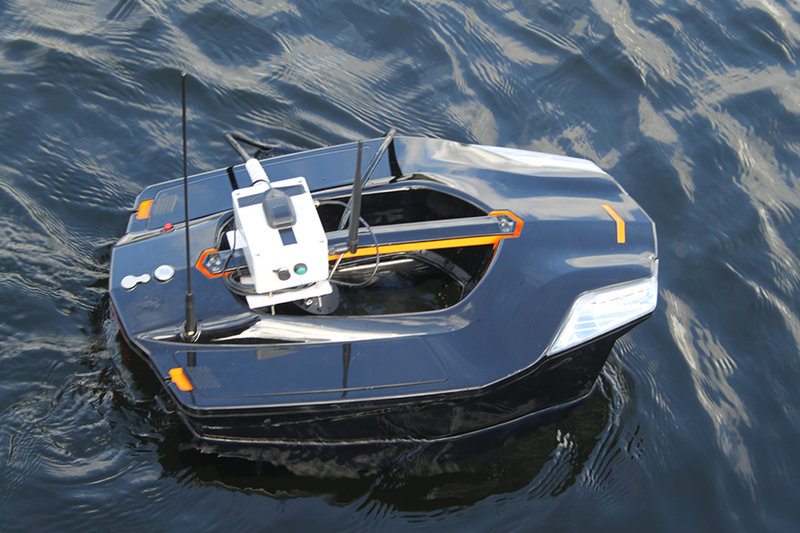Innovation spotlight
Fostering innovation: a success story
We hear from City of Glasgow College about one of its most successful innovation projects, which helped a student entrepreneur develop a new technology with support from two Scottish funding bodies.
A student entrepreneur in Scotland has developed an innovative remote water monitoring system in collaboration with City of Glasgow College and CENSIS.
Electrical engineering student Dale Colley set out to develop a remote water monitoring system that would improve the way bodies of water are monitored and samples are taken, in a bid to support a more sustainable use of water.
Together with the City of Glasgow College’s Innovation & STEM team and with funding from Scottish funding bodies, Colley developed Aquabot. The remotely operated vehicle (ROV) can carry a range of sensors on a catamaran hull and can be deployed on large bodies of inland water.
After developing a successful prototype in partnership with the City of Glasgow College’s Innovation & STEM team and CENSIS, Colley’s company Altitude Thinking is now working to bring the technology to market.
There’s something in the water: meet Aquabot
Colley says that two primary goals for Aquabot were to solve difficulties in accessing bodies of water to improve data collection, as well as providing a carbon-neutral method to collect water samples.
"The idea for Aquabot came from looking at the current water sampling and water quality data collection methodology that was being used by the water sector,” says Colley. “I saw that a lot of water was not being monitored or sampled, therefore I saw this as an opportunity to combine ROV technology with the current methodology technology to help access more areas of water.”
The ROV has a radio control range of 1000m and an operating time of up to six hours and can travel to 500 different points of interest. A GPS-based autopilot adds further range and autonomous capabilities. Use of the Aquabot can reduce the need to send field operatives on the water in a boat, help to reach difficult-to-access areas for sampling, and reduces health and safety risks for operators.

Dale Colley demonstrates his invention, which he developled with help from City of Glasgow College’s Innovation & STEM team and two Scottish funding bodies.
A team effort in development and funding
Aquabot’s initial prototype was designed with technical and professional support from the City of Glasgow College’s Innovation & STEM team. The college also supported the development of the software for the second version of Aquabot, along with the accompanying app.
The team started working on the concept in January 2018. Initial funding for the first prototype came from Interface through its innovation voucher scheme, which awards £5,000 to universities and colleges to work with SMEs and develop their ideas and products. CENSIS funded the second stage of the project with £35,000, which took Aquabot from a prototype to a marketable product between June 2020 and October 2021 while navigating around delays and challenges caused by the Covid-19 pandemic.
Altitude Thinking is set to embark on two pilot projects with two utility companies to demonstrate the capabilities of Aquabot, according to Colley.
“This is an innovative solution compared to traditional water testing and gives several benefits including costs, ease of use, health and safety benefits, and data quality,” says Linus Reichenbach, project manager for STEM and Innovation at City of Glasgow College. “For us, this project is also a great example that we can take those small innovation voucher projects a step further, get other partner involved and really open even more opportunities for the SMEs that we are supporting.”

Aquabot in the water. Altitude Thinking is now working on pilot projects with two utility companies to demonstrate the system's capabilities.
Fostering innovation at City of Glasgow College
The story of Aquabot’s development shines a spotlight on how innovation is fostered at City of Glasgow College, and in particular the work of the Innovation & STEM team.
“The college has been leading our joint funding applications and has been involved in many of the technical aspects of the prototype development,” says Reichenbach. “Together, we have been investigating and deciding between different technology options to include in the prototype and one of our lecturers has been responsible for the software and app development.
“Besides that, we have supported Dale throughout the last years with advice and have used our connections and college events – for example around COP26 – to get him in touch with potential clients and stakeholders.
“This is one of our most successful projects and we see this as a blueprint of how we can support SMEs and get staff around the college involved with innovation projects. This was our first innovation voucher funding, and we have, over the years, built on this experience and have now had ten successful innovation voucher projects with different companies.”